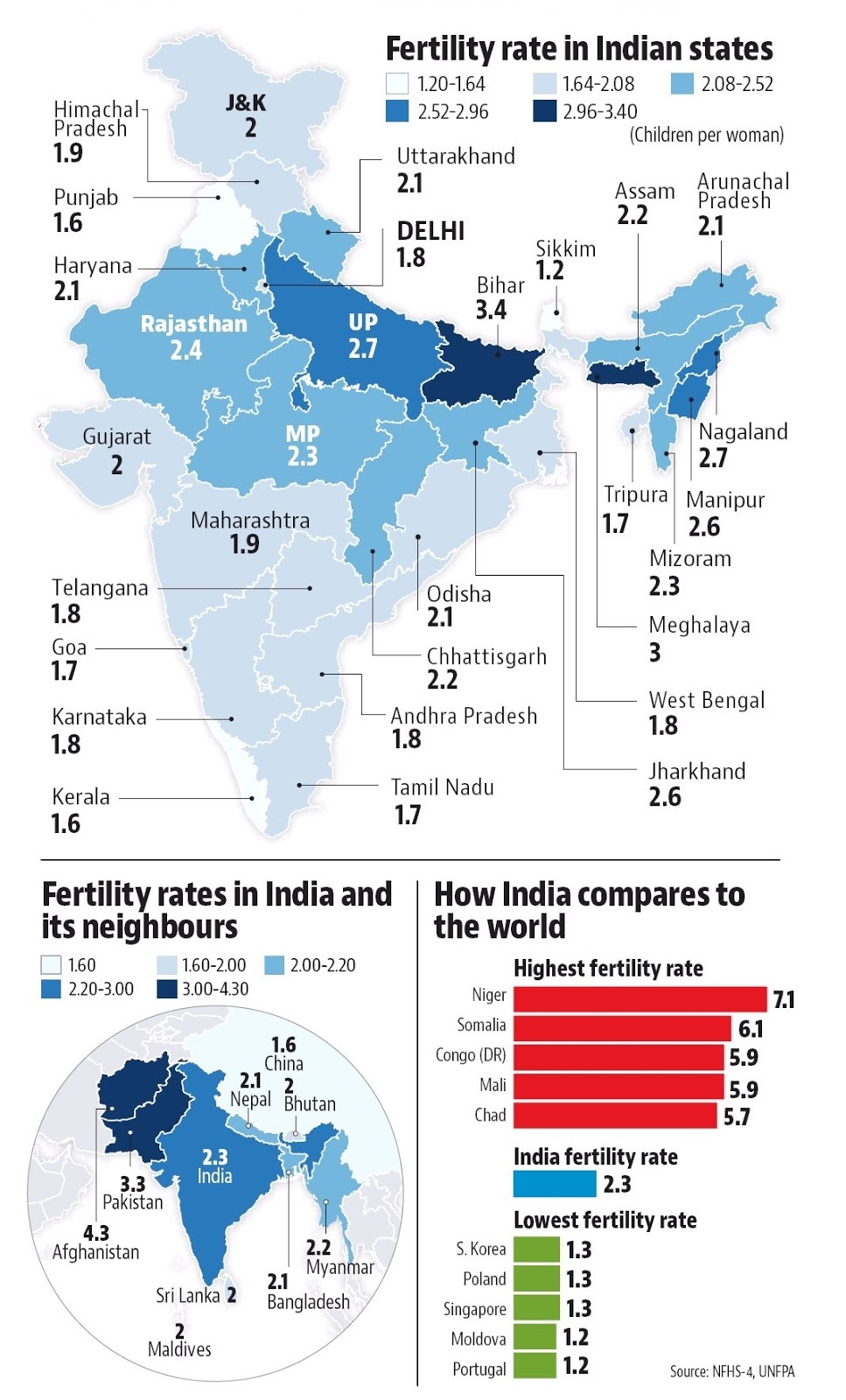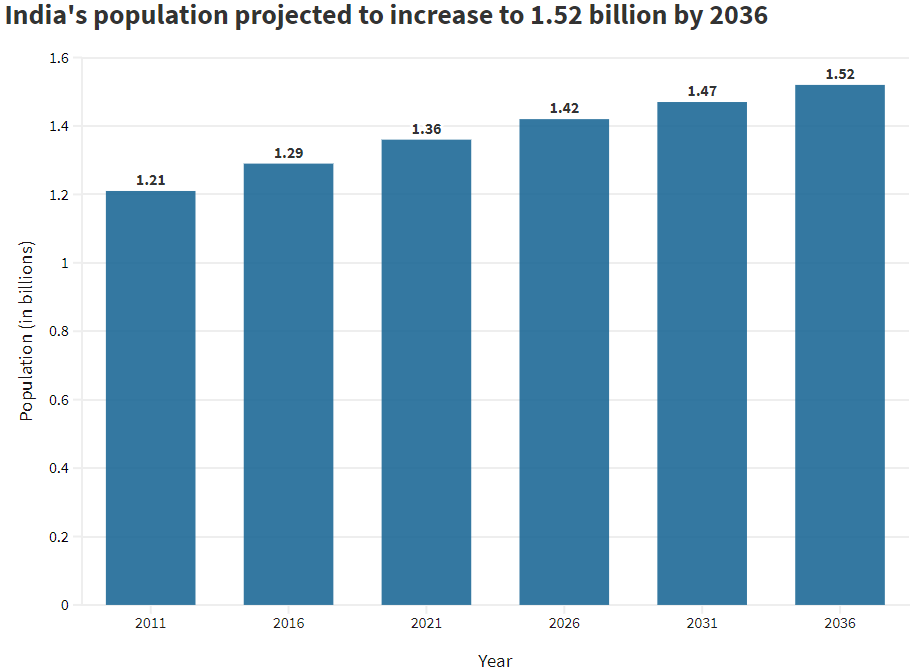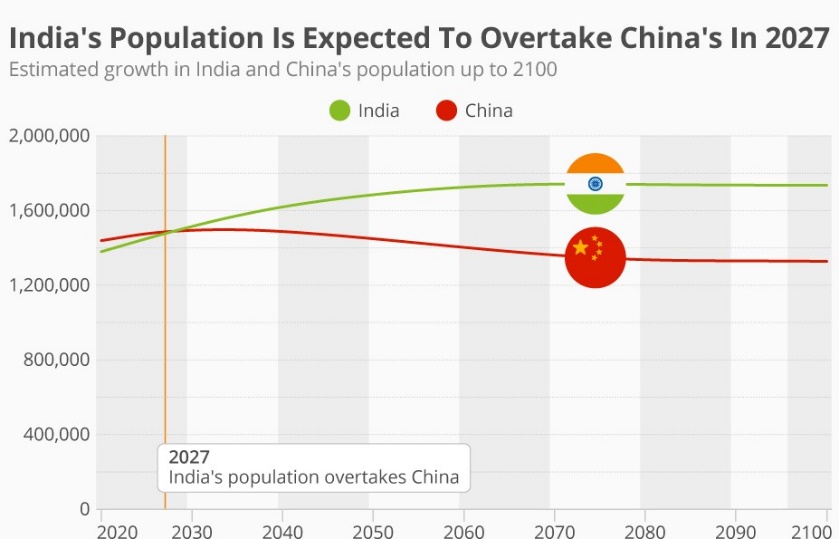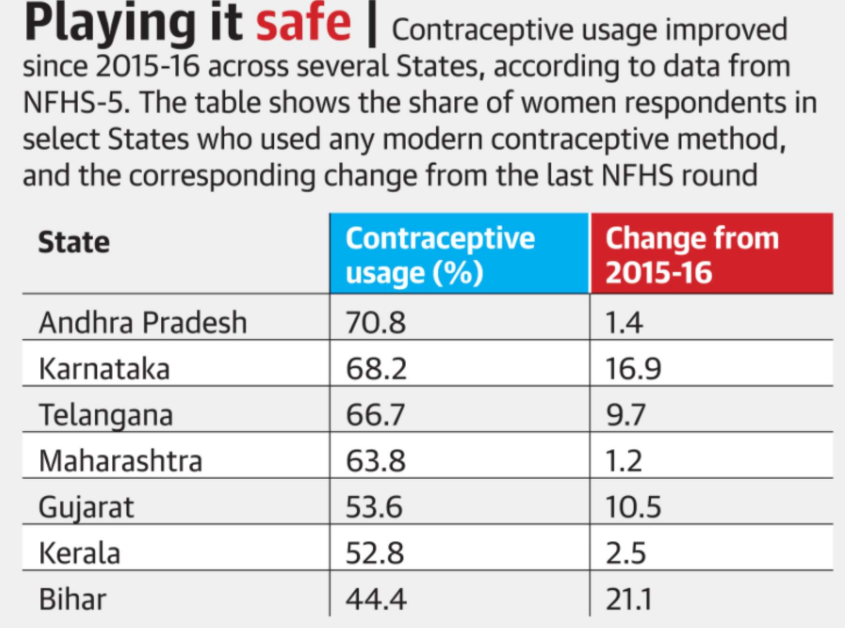Population management and Two Child policy
2021 JUL 13
Mains >
Social justice > Human Resources > Population & Census

IN NEWS
- A private members' bills on population control is set to be introduced in the upcoming Monsoon session of Parliament.
- The private members' bill comes close on the heels of Uttar Pradesh’s new population policy for 2021-2030 and a draft bill on population control.
INDIA’S POPULATION GROWTH PROJECTIONS:

- India’s population was 1.21 billion as per the Census of 2011. According to the technical group on population projections, the population will grow by 25%, with reference to 2011, to 1.52 billion by 2036.
- The group was constituted by the National Commission on Population (NCP) under the Ministry of Health and Family Welfare (MoHFW).
- According to these projections, India will overtake China as the world’s most populous country around 2031, much later than the United Nations projection of 2027.

- As much as 54% of the growth in population in India between 2011 and 2036 will take place in the five states of UP, Bihar, Maharashtra, West Bengal and Madhya Pradesh.
- In the 2011-2036 period, the Total fertility rate (TFR) in India will decline to 1.73 with the assumption that the current pace of decline is maintained. According to the report, the only Indian state with a TFR higher than 2 by 2035 will be Bihar at 2.38.

- The report projects that as much as 70% of the population increase will be in urban areas. India’s urban population will increase from 377 million in 2011 to 594 million in 2036 – a growth of 57%.
- UNICEF estimates that around 25 million children are born every year in India, accounting for a fifth of the world's annual births.
KEY DATA FROM NFHS-5:

- The fertility rate stands at 2.2 at present, just above the replacement fertility level of 2.1 which is the mark of population stabilization.
- Total Fertility Rate (number of children born per woman) has decreased across 14 out of 17 States and is either at 2.1 children per woman or less.
- This also implies that most States have attained replacement level fertility, i.e., the average number of children born per woman at which a population exactly replaces itself from one generation to the next
- The number of districts with a modern contraceptives prevalence rate of over 60% has also increased significantly. This change was much better in Maharashtra, Karnataka, Andhra Pradesh, Telangana and Kerala.
- The total fertility rate for urban India was 1.8, for rural India 2.4, for women with no schooling 3.4 and 1.7 for women with 12 years or more education.
STATUS OF TWO CHILD NORM IN INDIA:
- Entry 20-A in the Concurrent List deals with population control and family planning. This provision was added through the 42nd Constitutional Amendment Act of 1976.
- Currently, there is no national policy mandating two children per family. However, the various population control strategies in India encourage two-child norm. Since the early 1990s, 12 states have introduced some version of the two child-policy.
GOVERNMENT MEASURES TOWARDS POPULATION CONTROL:

- Minimum age of Marriage:
- Age of marriage and fertility rates are inversely related. In India, minimum age for marriage is 21 years for men and 18 years for women has be fixed by law.
- National Population Policy 2000:
- Immediate Objective: to address the unmet needs for contraception, health care infrastructure and health personnel and to provide integrated service delivery for basic reproductive and child health care.
- The Medium-Term Objective: to bring the Total Fertility Rate (TFR) to replacement level by 2010 through vigorous implementation in inter-sectorial operational strategies.
- The Long-Term Objective: to achieve a stable population by 2045 at a level consistent with the requirements of sustainable economic growth, social development, and environment protection.
- Mission Parivar Vikas:
- It seeks to increase access to contraceptives and family planning services in 146 high fertility districts with Total Fertility Rate (TFR) of 3 and above in seven high focus states.
- These districts are from the states of Uttar Pradesh, Bihar, Rajasthan, Madhya Pradesh, Chhattisgarh, Jharkhand and Assam that itself constitutes 44% of the country’s population.
- New Contraceptive Choices:
- In recent years, government has increased its attention to the unmet contraceptive needs by promoting birth spacing and introducing free injectable contraception.
- Eg: ‘Antara’ And ‘Chhaya’ contraceptives were introduced by MoHFW to bring down fertility rate to 2.1% by 2025.
- Compensation scheme for sterilization acceptors:
- Under the scheme, MoHFW provides compensation for loss of wages to the beneficiary and also to the service provider (& team) for conducting sterilizations.
- Clinical Outreach Teams (COT) Scheme:
- The scheme has been launched in 146 Mission Parivar Vikas districts for providing Family planning services through mobile teams from accredited organizations in far-flung, underserved and geographically difficult areas.
- Promotional activities like Saas bahu sammelans, Nayi Pehel Kits, Mobile publicity vans, and advocacy meetings are undertaken to increase awareness in high fertility Mission Parivar Vikas districts.
- National Family Planning Indemnity Scheme (NFPIS): under which clients are insured in the eventualities of deaths, complications.
- Schemes involving ASHA workers:
- for home delivery of contraceptives at doorstep of beneficiaries.
- for ASHAs to Ensure spacing in births.
- for provision of Pregnancy Testing Kits.
- Family Planning Logistic Management and Information System (FP-LMIS): A dedicated software to ensure smooth forecasting, procurement and distribution of family planning commodities across all the levels of health facilities.
- 360-degree media campaign: comprises of TV Commercials, posters and hoardings, yearlong Radio show, and a dedicated website on Family Planning.
- World Population Day & fortnight as well as Vasectomy Fortnight are observed every year to boost awareness.
- Initiatives at the state level:

-
- Several states like Haryana, Rajasthan, Gujarat, Maharashtra, Madhya Pradesh, Andhra Pradesh and Himachal Pradesh have made the two-child norm mandatory for contesting in local self-government elections.
- In Madhya Pradesh, state civil service rules make it ineligible for the 3rd child to apply for Government jobs.
- In Rajasthan and Maharashtra, candidates who have more than two children are not eligible for appointment to government jobs.
- Assam Cabinet has decided that those with more than two children will be ineligible for government jobs from 2021.
|
WHAT IS TWO CHILD POLICY?
- It is a state-imposed limit of two children allowed per family or the payment of government benefits only to the first two children or parents with only two children.
STATUS OF TWO CHILD POLICY ACROSS WORLD:
- A two-child policy has previously been used in several countries including Iran, Singapore, and Vietnam.
- In British Hong Kong in the 1970s, citizens were also highly encouraged to have two children as a limit (although it was not mandated by law), and it was used as part of the region’s family planning strategies.
- Since 2016, it has been re-implemented in China replacing the country’s previous one-child policy.
|
WHY INDIA NEED STRONGER POPULATION CONTROL POLICIES?
- Address developmental demands:
- India is currently expected to overtake China as the world's most populous country by 2027, per a 2019 UN report. A controlled population growth is essential to sufficiently meet the aspirations of this growing population in areas of education, health, skills and employment.
- Address regional imbalances:
- Because of their population size, some states have more representatives in Lok Sabha. To combat regional imbalance in population and democratic representation by the various state in the parliamentary democracy system, a strong population control will be helpful.
- Failure of earlier policies:
- Despite having population policies, India’s population has doubled in the last 40 years. Measures such as the National Population Control Policy (2000) has failed to attain its targets, making India the second-most populous country in the world. Hence, measures like the two-child policy are needed.
- For sustainable development:
- India’s natural resources are extremely over-burdened and facing over-exploitation, especially the common pool resources such as air and water. Without an optimum population, sustainable development will be arduous task.
- Bridge inequality:
- According to Oxfam’s report, India's richest 1 % hold more than four-times the wealth held the bottom 70 % of its population. Without regulating the rising population, this gap will worsen.
- Rise of Industrial revolution 4.0:
- The upcoming era of industrialization is focused on information-intensive transformation of manufacturing and related industries into smart factories. Here, quality of population (i.e skill levels) rather than quantity is key.
ARGUMENTS AGAINST STRONG POPULATION CONTROL POLICIES:
- Findings of NFHS 5: Data from the National Family Health Survey-5 (NFHS-5) shows that the country’s population is stabilizing.
- NFHS-5 provides evidence of an uptake in the use of modern contraceptives in rural and urban areas, an improvement in family planning demands being met, and a decline in the average number of children borne by a woman.
- The figures indicate that education and health care are the most crucial inputs to reducing the population.
- It is a myth that the poor want more children. They have more children as they often have no access to reversible contraception methods.
- Perpetuates Gender bias:
- Population control measures are often discriminatory against female. Eg: Even without mandatory policies, women remain the dominant acceptors for permanent birth control measures, like tubectomy, in India. A strong population control policy will only increase this bias.
- Also, strong policies can increase son preference and son meta-preference, which could get manifested into sex selective abortions and female infanticides.
- China’s ominous experience:
- There are already well-documented problems with China’s one-child policy, namely population stagnation and the gender imbalance resulting from a strong preference for boys.
- Loss of demographic dividend:
- International experience shows that any coercion to have a certain number of children is counterproductive and leads to demographic distortions. A restricted child policy will create a shortage of educated young people needed to carry on India’s technological revolution.
- Heavy dependency ratio:
- With a declining population growth, the number of old people receiving social services will be larger than the young tax base that is paying for the social services. This will create burden on the public exchequer.
- Eg: By 2031, almost half of Kerala and Tamil Nadu's population is expected to be 40 years or older. It will be a challenge for these states to address the needs of its geriatric population.
- Failure of government:
- Rising population is an indication of the government’s inability to provide essential health, education and livelihood avenues for people. Critics argue that the population growth will slow down naturally as the country is able to provide such amenities to the people.
- Success of South Indian states:
- Kerala, Karnataka and Tamil Nadu have shown a replicable model in population control. These states have made a remarkable drop in fertility rates with no stringent norms in place, through focus on maternal and infant healthcare, women empowerment and public sensitization.
- Negative consequences of excluding ‘Third Child’:
- Violation of the constitutional Right to Education (Article 21A, Article 45 and 51A) and Right to Life (Article 21) and also the United Nations Convention on Rights of Child.
- Deprivation of the opportunity to contest elections:
- A study conducted in five Indian states showed that the two-child norm was responsible for the largest number of disqualified candidates in panchayat elections. Of these, Dalits, Adivasis and OBCs formed an overwhelming 80%.
- Hence, such policies contravene the 73rd amendment, which aims to give political representation to people from marginalized communities in democratic processes.
- Violates international agreements:
- India is a signatory to the Programme of Action (POA) of the International Conference on Population and Development, 1994, which is unequivocally against coercion in family planning.
WAY FORWARD
- Thrust on development:
- Development is the best method for controlling population. Globally, it is seen that as the wealth status of families improves, the total fertility rate decreases. Hence, focus should be on providing an enabling environment for people to
- Improve accessibility:
- Young women and men need access to quality family planning services and spacing methods of contraception. Providing better access and quality of health care for young people will not only lead to improved health but will also visibly improve educational outcomes and increase productivity and workforce participation.
- Replicate successful models:
- States in southern part of India have been at the forefront in improving the social indicators like the literacy rate, especially among females, are better than the rest of the country. Taking cue from their strategies, other states can focus on overall social development along with promotion and strengthening of existing family planning programs.
- Women empowerment:
- Studies have shown that female education is highly correlated with lower fertility rates, which equates to lower population growth. Empowerment of women, including autonomy in the use of contraception, is a major factor that contributes to better demographic outcomes.
- Constitutional recognition:
- National Commission to Review the Working of the Constitution had recommended in 2002, that Directive Principle of State Policy Article 47A to be inserted into the Constitution to control population explosion.
PRACTICE QUESTION:
Q. Population dynamics play an important role in the achievement of social, economic and environmental development. In this regard, critically examine the need of a mandatory two-child policy in India?






